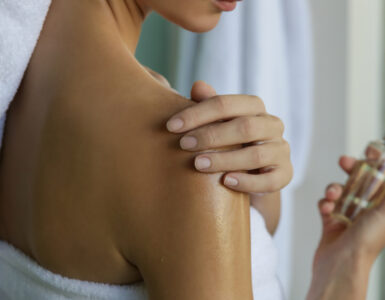Dr. Steve Jepson explains how this treatment can improve your skin’s health and overall appearance.
Can applying acid to your face help you look younger? Some people may think that sounds a little crazy. After all, we are generally taught that acids will burn and damage skin. But certain acids are very safe for regular use on the skin, and these acids are used during the very common aesthetic procedure called a chemical peel. Regular chemical peels are an economical and effective way to improve your skin’s health and help you look your youngest.
In esthetics, we use several kinds of skin-safe acids including glycolic, lactic, salicylic, and kojic acids to perform chemical peels. Acids work their magic by dissolving things. Obviously, we want the acid to dissolve the bad, but not the good. These skin-safe acids, also known as alpha-hydroxy and beta-hydroxy acids, do just that (when used in the correct concentrations.) These acids will:
1. Dissolve the chemical bonds that hold the dead outer layer of skin (called the stratum corneum) together. These old skin cells will then slough off over the few days following the treatment. The end result is smoother, brighter, healthier looking skin.
2. Dissolve any dirt and debris that your cleanser isn’t regularly removing, especially the dirt and debris down deep in your pores. The end result is smaller pores.
3. Stimulate new collagen formation. The acid will cause microscopic irritation to the deeper layers of skin which results in new collagen formation. The end result is smoother, younger looking skin
4. Dissolve unwanted pigment. Mild sun spots can fade with regular chemical peels.
The procedure is best performed by a master esthetician – a skin care specialist who has been specifically trained in the art of chemical peels. Master estheticians working in doctor’s offices are allowed to perform more aggressive peels using higher concentrations of the acids (as opposed to estheticians working at day spas or salons). Higher acid concentrations will achieve better results.
The procedure itself is very simple. Following several cleansing steps, a thin layer of the liquid acid is gently applied to the skin using a gauze pad. Depending on the type of chemical peel, more than one layer or type of acid can be applied. The acid is allowed to sit on the skin for several minutes before it is washed off.
A chemical peel can sting a little bit, but it’s generally not a painful procedure. As the “dissolved” skin cells slough off, you can expect some mild skin peeling for a few days and a little bit of redness, but overall, the downtime is minimal. You can certainly go about your normal business following a chemical peel.
During the month of January, chemical peels are on sale at my office. Get 1 for only $60 or a package of 3 for $150. Call (801) 281-0022 for more details or to schedule an appointment.
Dr. Steven Jepson, M.D.
The Spa at the Utah Dermatologic & Medical Procedures Clinic
154 E. Myrtle Ave (5065 S) #102
(just off State Street in Murray)
(801) 281-0022
www.UDMPC.com
















Add comment